Subscribe to our ▶️ YouTube channel 🔴 for the latest videos, updates, and tips.
Subtracting 1-Digit Number
In subtracting 1-digit number we will subtract or minus one-digit number from one-digit number or one-digit number from 2-digit number and find the difference between them.
We know that subtraction means to take away a set of objects from a collection.
We use – sign to take away
9 - 6 = 3
We say that difference between 9 and 6 is 3.
● Mary had 3 bananas.
She gave 1 banana to James.
Now she 2 bananas.
When we take away objects from a collection, we are subtracting.
We have : 1 taken away from 3 is 2.
We write : 3 - 1 = 2
We say : 3 minus 1 is 2.
- is the sign for taking away or subtraction. We read - as minus.
When we subtract 0 from a number, the number remains the same.
When we subtract the number from itself we get 0.
If from six things we take away 2 things, then four things are left. In arithmetic this is written in a short way as follows:
6 – 2 = 4
The symbol – is called the minus sign and shows that the number written after it is to be subtracted, or taken away, from the number written before it.
We may read 6 – 2 = 4 as ‘six minus two is equal to four’ or ‘six less two is four’.
We have learnt that we can subtract numbers by counting backward.
8 - 3 = ?
Counting backward from 8, take jumps backward. You reach 5.
Subtracting 1-Digit Number Video
Subscribe to our ▶️ YouTube channel 🔴 for the latest videos, updates, and tips.
How to subtract two one-digit numbers?
1. Here we will find 2 – 1.
Follow the steps along with the picture:
(i) 2 – 1 means start with 2 and take away 1.
(ii) From 2 strokes we take away 1 stroke and cancel the strokes.
(iii) So, 1 stroke is left.
(iv) Therefore, 2 – 1 = 1
We may read 2 – 1 = 1
as ‘two minus one is equal to one’
or ‘two less one is one’.
2. Here we will find 5 – 3.
Follow the steps of subtracting 1-digit number along with the picture:
(i) 5 – 3 means start with 5 and take away 3.
(ii) From 5 strokes we take away 3 strokes and cancel the strokes.
(iii) So, 2 strokes are left.
(iv) Therefore, 5 – 3 = 2
We may read 5 – 3 = 2 as ‘five minus three is equal to two’ or ‘five less three is two’.
3. Here we will find 7 – 2.
Follow the steps along with the picture:
(i) 7 – 2 means start with 7 and take away 2.
(ii) From 7 strokes we take away 2 strokes and cancel the strokes.
(iii) So, 5 strokes are left.
(iv) Therefore, 7 – 2 = 5
We may read 7 – 2 = 5 as ‘seven minus two is equal to five’ or ‘seven less two is five’.
4. Here we will find 9 – 5.
Follow the steps of subtracting 1-digit number along with the picture:
(i) 9 – 5 means start with 9 and take away 5.
(ii) From 9 strokes we take away 5 strokes and cancel the strokes.
(iii) So, 4 strokes are left.
(iv) Therefore, 9 – 5 = 4
We may read 9 – 5 = 4 as ‘nine minus five is equal to four’ or ‘nine less five is four’.
5. Here we will find 8 – 8.
Follow the steps of the subtraction of 1-digit number along with the picture:
(i) 8 – 8 means start with 8 and take away 8.
(ii) From 8 strokes we take away 8 strokes and cancel the strokes.
(iii) So, 0 strokes are left.
(iv) Therefore, 8 – 8 = 0
We may read 8 – 8 = 0 as ‘eight minus eight is equal to zero’ or ‘eight less eight is zero’.
SUBTRACTION PROPERTIES
Let us learn the properties of subtraction.
Subtraction of 0
What do you get when you subtract 0 from a number?
When 0 is subtracted from a number, the difference is the number itself.
Try This!
Fill in the boxes.
6 - 0 = _____
5 - 0 = _____
_____ - 0 = 7
9 - _____ = 9
Subtraction of 1
What do you get when you subtract 1 from a number?
When 1 is subtracted from a number, the difference is the previous number.
Try This!
1. Fill in the boxes.
5 - 1 = _____
8 - 1 = _____
_____ - 1 = 7
9 - _____ = 8
How many left?
2. (i) Ashley had 3 lollipops.
She ate 2 lollipops.
How many left?
(ii) There were 4 parrots.
1 parrot flew away.
How many left?
(iii) There were 5 balloons.
3 balloons were burst.
How many left?
(iv) There were 6 bananas.
We ate 3 bananas.
How many left?
Worksheet on Subtracting 1-Digit Number
Questions and Answers on Subtracting 1-Digit Number:
1. Cross out 6 objects and find the difference.
Answer:
1. (i) 6
(ii) 9
2. (i) Take away 0 from 9. How many left? _____
(ii) Take away 6 from 6. How many left? _____
Answer:
2. (i) 9
(ii) 0
3. Subtract and find the difference.
(i) 18 - 7 = _____
(ii) 14 - 3 = _____
(iii) 18 - 8 = _____
(iv) 16 - 4 = _____
(v) 19 - 9 = _____
(vi) 15 - 2 = _____
Answer:
3. (i) 11
(ii) 11
(iii) 10
(iv) 12
(v) 10
(vi) 13
4. Find the difference.
(i) 27 - 5 = _____
(ii) 88 - 6 = _____
(iii) 67 - 2 = _____
(iv) 48 - 8 = _____
(v) 39 - 3 = _____
(vi) 55 - 5 = _____
(vii) 49 - 1 = _____
(viii) 19 - 5 = _____
Answer:
4. (i) 22
(ii) 82
(iii) 65
(iv) 40
(v) 36
(vi) 50
(vii) 48
(viii) 14
5. Subtract the following:
|
(i) |
T O 8 - 2 ________ |
(ii) |
T O 1 3 - 1 ________ |
|
(iii) |
T O 4 4 - 2 ________ |
(iv) |
T O 1 8 - 3 ________ |
Answer:
5. (i) 6
(ii) 12
(iii) 42
(iv) 15
6. Fill in the blanks:
Answer:
6. (i) 5
(ii) 7
(iii) 4
(iv) 3
7. Find the difference.
(i) 8 - 0 = 8
(ii) 6 - 0 = _____
(iii) 9 - 0 = _____
(iv) 4 - 0 = _____
(v) 5 - 0 = _____
(vi) 7 - 0 = _____
Answer:
7. (ii) 6
(iii) 9
(iv) 4
(v) 5
(vi) 7
8. Find the difference.
(i) 4 - 1 = 3
(ii) 8 - 1 = _____
(iii) 7 - 1 = _____
(iv) 3 - 1 = _____
(v) 5 - 1 = _____
(vi) 2 - 1 = _____
(vii) 6 - 1 = _____
(viii) 9 - 1 = _____
Answer:
8. (ii) 7
(iii) 6
(iv) 2
(v) 4
(vi) 1
(vii) 5
(viii) 8
9. Subtract on Abacus. One has been done for you.
Answer:
9. (ii) 45
(iii) 42
10. Fill in the boxes. One has been done for you.
11. Word Problems on Subtracting 1-Digit Number:
(i) What is left when 1 is subtracted from 5? 3 from 8? 5 from 9?
(ii) What must be added to 3 to make 5? to 2 to make 9? to 4 to make 8?
(iii) George has 7 cows; Jason has 5 cows. How many more cows has George than Jason?
(iv) By how much is 3 less than 6?
(v) Nine minus two is equal to seven'. Write that in a short way, using figures and signs only.
(vi) A jug can hold 8 litres of milk. There are now 5 litres in it. How many more litres are needed to fill the jug?
(vii) A boy worked 6 sums. If 2 of them were wrong how many did he get right?
(viii) Brandon is 9 years old and Alexander 4 years old. By how many years is Brandon older than Alexander?
(ix) I went to the bazaar with 7 rupees. After buying meat and vegetables I had 3 rupees left. How many rupees did I spend?
Answer:
11. (i) 4; 5; 4
(ii) 2; 7; 4
(iii) 2
(iv) 3
(v) 9 - 2 = 7
(vi) 3 litres
(vii) 4
(viii) 5 years
(ix) ₹ 4
12. There are 45 students in a class. 7 students were absent on Friday. How many students were present in the class on Friday?
Answer:
12. 38
From Subtracting 1-Digit Number to HOME PAGE
Didn't find what you were looking for? Or want to know more information about Math Only Math. Use this Google Search to find what you need.




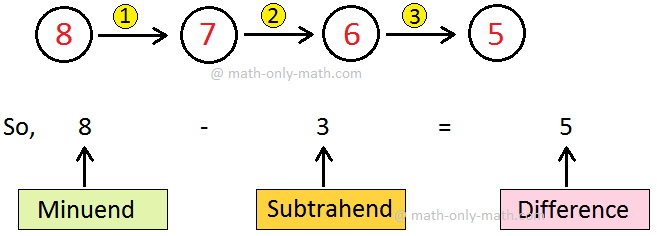
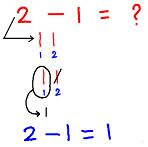
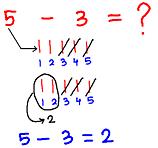
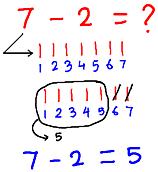
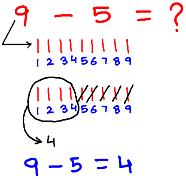
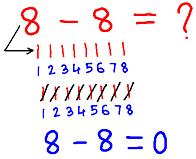

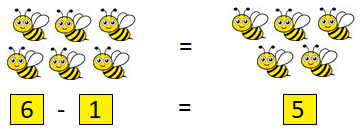
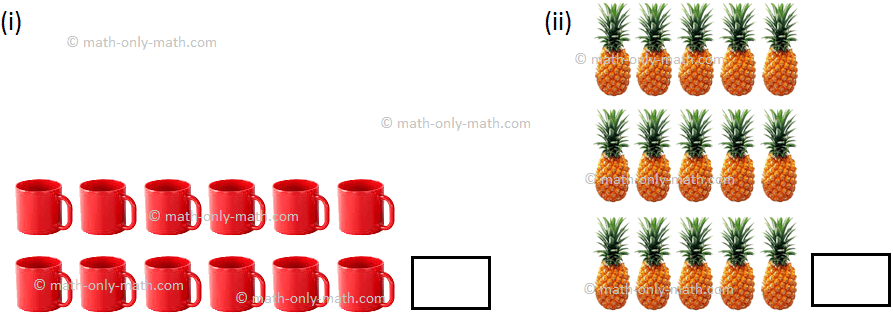



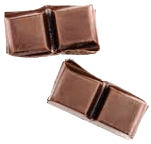
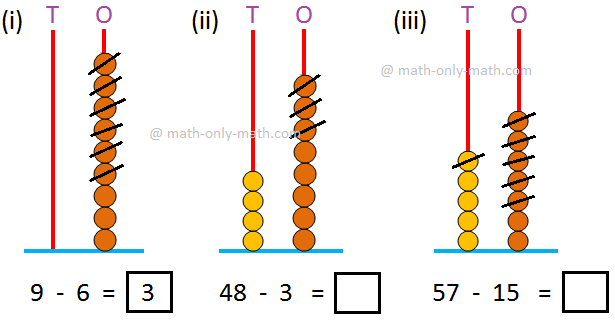
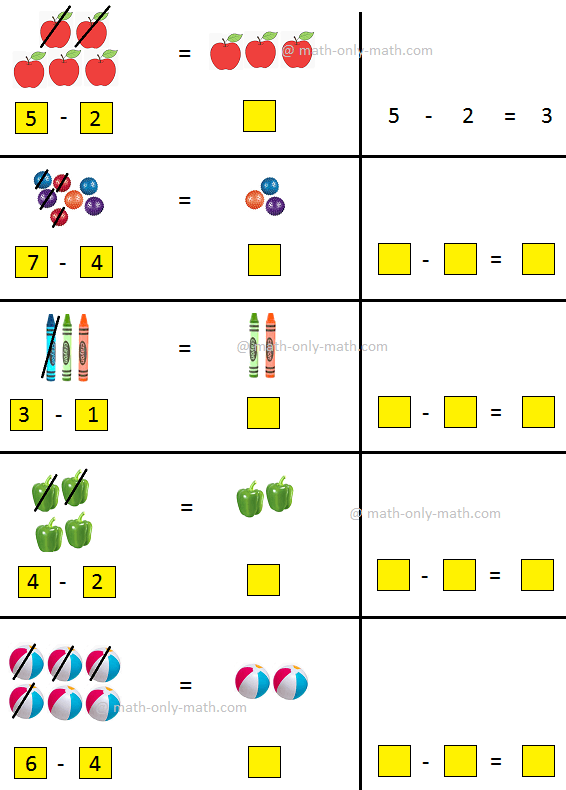


New! Comments
Have your say about what you just read! Leave me a comment in the box below. Ask a Question or Answer a Question.